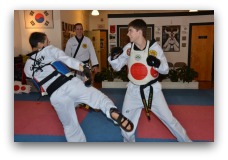This article was published in Taekwondo Times Magazine issue #67 August, 2013
Taoism and its reliance on the Way or path of natural order,
remains a cornerstone of Asian thought to this day and has given rise to what
is perhaps one of the most recognized icons of all time: the Yin/Yang.
This eternal symbol, rooted in the ancient Chinese Book of Changes, or I Ching (Korean: Juyeok),
is composed of two tear-shaped elements circling one another. Nestled in the
lobe of each is a representative sample of its mate. On a three dimensional
level, this elementary circle can be extrapolated into two, discreet orbiting
polarities thus giving rise to a spiral, satisfying both the cyclical and
linear nature of life as we travel through time.
Yet, how does this timeless icon apply to the Korean
discipline of tae kwon do? The answer to this question lies in how deeply the
practitioner wishes to probe the metaphysical aspects of the martial arts. Taking
a utilitarian approach to the basic theme underscoring the Eum/Yang can have a
significant impact on the practical application of tae kwon do technique in
general. For example, poomsae, hyung
or tul, the choreographed formal
exercises that stand as a central pillar of traditional tae kwon do, borrow
heavily from the philosophical principles surrounding the I Ching. Each of the
Kukkiwon gup or color belt poomsae
draw their philosophical individualism from the Palgwe whose eight sets of
trigrams surrounding the Eum/Yang represent nature in its fullness. The natural
elements of heaven, thunder, wind, water, fire and earth, are all in evidence
as the practitioner learns to overcome the physical limitations of the body,
instead experiencing the spiritual aspects supported by these components while
performing this brand of moving meditation.The Ying/Yang furthermore acts as a metaphor for the duality
of opposites; the struggle between two opposing forces to exist in a state of
equilibrium. Moreover, it embraces a belief in constant change as a central
dynamic of daily life. Even though certain characteristics of this time-honored
symbol are altered somewhat in the Korean Eum/Yang and the Japanese In/Yo, the
underlying principles inherent in its design remain fixed. Depicted in its
elegance is the never-ending harmony that exists between two unlike forces;
forces such as light and dark, soft and hard, right and left, good and evil,
and night and day. This harmonic resolution rests on the fact that, rather than
negating one another, these contradictions are supportive in their oneness. Eum
is considered the passive, receptive polarity, while Yang can be thought of as
the assertive or active partner. Dividing them is a high-energy, sine-curve
boundary line. Rather than remaining in a static state, this division vibrates
kinetically with Ki, the vital life
force.
Meditating on the Eum/Yang, one ultimately concludes that
almost everything we do in tae kwon do returns to this elegant symbol. From the
give and take of self-defense drills, where one practitioner lends their body
to another under the shadow of potential injury, to the relaxed state of the
muscles as a prelude to the penetrating power of a kick or a strike, harmony
between opposites abound. A healthy, balanced juxtaposition between competition
and practical self-defense must be maintained as well if the art and sport of
the discipline are to coexist in concordance with one another, ultimately
benefiting both sides of the equation.
Finally, if we hope to realize a substantive gain from our practice,
we must cultivate a deep appreciation for the breath containing Ki, the universal
life force. Therefore, if the Eum/Yang exhibits anything in its extreme
simplicity, it is the smooth transfer of breath - inhalation and exhalation
particularly during meditation - as it mindfully enters and leaves the body.
This action clearly provides potential energy coupled with an amplification of
technique so vital to the martial artist.
Unquestionably, tae kwon do is about kicking, striking and
self-defense. Moreover, it has clearly blossomed into a world sport with full
recognition by the International Olympic Committee. Yet, as in the past, it
remains a vehicle for developing a strong character and a sharp mind. One is
constantly reminded of this dichotomy by the universal symbol of the Eum/Yang.
Master
Doug Cook,
a 6th dan black belt, is head instructor of the Chosun Taekwondo
Academy located in Warwick, New York, a senior student of Grandmaster Richard
Chun, and author of four best-selling books focusing on taekwondo. He can be
reached for lectures, workshops or questions at www.chosuntkd.com or info@chosuntkd.com.
.JPG)



